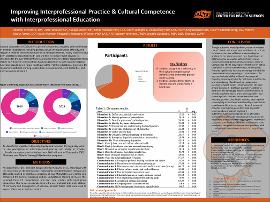| dc.contributor.author | McIntosh, Haddon | |
| dc.contributor.author | Weaver, Luke | |
| dc.contributor.author | Ricken, Rileigh | |
| dc.contributor.author | Madrak, Emily | |
| dc.contributor.author | Volberding, Jennifer L. | |
| dc.contributor.author | Harrison, Amy | |
| dc.contributor.author | Bray, Natasha | |
| dc.contributor.author | Farrar, Nicole | |
| dc.contributor.author | Murray, Kelly | |
| dc.contributor.author | O’Brien, Matthew | |
| dc.contributor.author | Wymore, Randy | |
| dc.contributor.author | Davidson, Brenda | |
| dc.contributor.author | Drinnon, Sally | |
| dc.date.accessioned | 2023-09-12T16:45:02Z | |
| dc.date.available | 2023-09-12T16:45:02Z | |
| dc.date.issued | 2022-02-18 | |
| dc.identifier | ouhd_McIntosh_improvinginterprofessionalpractice_2022 | |
| dc.identifier.citation | McIntosh, H., Weaver, L., Ricken, R., Madrak, E., Volberding, J. L., Harrison, A., Bray, N., Farrar, N., Murray, K., O’Brien, M., Wymore, R., Davidson, B., & Drinnon, S. (2022, February 18). Improving interprofessional practice and cultural competence with interprofessional education. Poster presented at Research Days at Oklahoma State University Center for Health Sciences, Tulsa, Ok. | |
| dc.identifier.uri | https://hdl.handle.net/11244/339534 | |
| dc.description.abstract | Challenge/Issue: Interprofessional education (IPE) and cultural competence (CC) training have become a staple in healthcare education programs with the ultimate goal of improving patient care. IPE, where students from two or more professions learn from, about, and with each other to optimize care, resulting in great team building, sharing of knowledge, communication, and collaboration. CC involves an individual’s ability to recognize, assess, appreciate, and respect unique backgrounds such as race, ethnicity, sexual minorities, gender, identity, religion, and age, to make greater informed decisions in healthcare and minimize inequities. Within educational programs, both constructs can occur simultaneously to optimize learning and patient-centered outcomes. | |
| dc.description.abstract | Objective: To identify the impact of a Diversity, Equity, and Inclusion IPE single-day event on the perceptions of interprofessional practice and ability to provide culturally competent care instudents enrolled in Doctor of Osteopathy (DO), Pharmacy, and Athletic Training (AT) education programs. | |
| dc.description.abstract | Approach: An experimental design used pre- and post-test measures of IPE and CC knowledge with a one day conference as the intervention. Participants included students (205- pre and 200- post) enrolled in DO, pharmacy, and AT programs at two Midwestern universities. Participants completed the Interprofessional Collaborative Competences Attainments Survey (ICCAS) and three modified components of the Tool for Assessing Cultural Competence Training (mTACCT) before and after the event that included baseline information about the different professions, three CC presentations, and two case studies with small group discussions. Due to uneven sample sizes in the pre- and post-test, and violations of normality and homogeneity of variance, Kruskal Wallis tests were used to assess differences in the intervention. | |
| dc.description.abstract | Results: Five items on the ICCAS and all items on the mTACCT demonstrated statistical significance. On the ICCAS, students demonstrated increases in their ability to; “actively list to Interprofessional (IP) team members’ ideas and concerns”, “working effectively with IP members to enhance care", “recognizing how others’ skills and knowledge complement and overlap with their own”, “to develop an effective care plan with IP team members”, and “negotiate responsibilities with overlapping scopes of practice”. This demonstrated that discussing the professions in general and utilizing case studies and small group discussions allowed students to understand the roles, skills, and responsibilities of their peer professionals which will lead to better communication and teamwork resulting in improved patient outcomes and satisfaction for both patients and staff. The results of the mTACCT demonstrated overall improvement in skills but highlighted students are consciously incompetent, where they recognize a deficiency but demonstrate a desire for greater understanding. Students felt that initially they lacked the ability to identify bias and stereotyping in healthcare but after the intervention felt better equipped. It is important to note that while we found improvements within CC, a single event should not be the only point of CC inclusion within curriculums. Our intervention provided students from three different healthcare programs with an educational opportunity to strengthen their skills in both IPE and CC | |
| dc.format | application/pdf | |
| dc.language | en_US | |
| dc.publisher | Oklahoma State University Center for Health Sciences | |
| dc.rights | The author(s) retain the copyright or have the right to deposit the item giving the Oklahoma State University Library a limited, non-exclusive right to share this material in its institutional repository. Contact Digital Resources and Discovery Services at lib-dls@okstate.edu or 405-744-9161 for the permission policy on the use, reproduction or distribution of this material. | |
| dc.title | Improving interprofessional practice and cultural competence with interprofessional education | |
| osu.filename | ouhd_McIntosh_improvinginterprofessionalpractice_2022.pdf | |
| dc.type.genre | Presentation | |
| dc.type.material | Text | |
| dc.subject.keywords | diversity education | |
| dc.subject.keywords | patient-centered care | |
| dc.subject.keywords | interprofessional education | |
